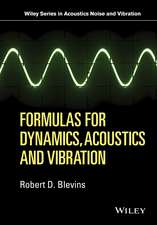Mechanics of Material Forces: Advances in Mechanics and Mathematics, cartea 11
Editat de Paul Steinmann, Gérard A. Mauginen Limba Engleză Hardback – 28 sep 2005
| Toate formatele și edițiile | Preț | Express |
|---|---|---|
| Paperback (1) | 643.34 lei 6-8 săpt. | |
| Springer Us – 8 dec 2010 | 643.34 lei 6-8 săpt. | |
| Hardback (1) | 649.54 lei 6-8 săpt. | |
| Springer Us – 28 sep 2005 | 649.54 lei 6-8 săpt. |
Din seria Advances in Mechanics and Mathematics
- 24%
 Preț: 782.70 lei
Preț: 782.70 lei - 18%
 Preț: 789.32 lei
Preț: 789.32 lei - 24%
 Preț: 703.34 lei
Preț: 703.34 lei -
 Preț: 395.47 lei
Preț: 395.47 lei - 18%
 Preț: 1006.06 lei
Preț: 1006.06 lei - 18%
 Preț: 1011.27 lei
Preț: 1011.27 lei - 15%
 Preț: 699.96 lei
Preț: 699.96 lei - 18%
 Preț: 951.91 lei
Preț: 951.91 lei - 18%
 Preț: 1388.36 lei
Preț: 1388.36 lei - 18%
 Preț: 1224.68 lei
Preț: 1224.68 lei - 18%
 Preț: 1670.41 lei
Preț: 1670.41 lei - 15%
 Preț: 648.89 lei
Preț: 648.89 lei - 15%
 Preț: 641.85 lei
Preț: 641.85 lei - 15%
 Preț: 695.01 lei
Preț: 695.01 lei - 18%
 Preț: 962.81 lei
Preț: 962.81 lei - 15%
 Preț: 642.51 lei
Preț: 642.51 lei - 18%
 Preț: 968.82 lei
Preț: 968.82 lei - 18%
 Preț: 947.50 lei
Preț: 947.50 lei -
 Preț: 400.85 lei
Preț: 400.85 lei - 20%
 Preț: 559.19 lei
Preț: 559.19 lei - 20%
 Preț: 561.11 lei
Preț: 561.11 lei - 15%
 Preț: 644.18 lei
Preț: 644.18 lei - 24%
 Preț: 790.70 lei
Preț: 790.70 lei - 18%
 Preț: 965.52 lei
Preț: 965.52 lei - 15%
 Preț: 648.24 lei
Preț: 648.24 lei
Preț: 649.54 lei
Preț vechi: 764.17 lei
-15% Nou
Puncte Express: 974
Preț estimativ în valută:
124.29€ • 129.77$ • 102.86£
124.29€ • 129.77$ • 102.86£
Carte tipărită la comandă
Livrare economică 04-18 aprilie
Preluare comenzi: 021 569.72.76
Specificații
ISBN-13: 9780387262604
ISBN-10: 0387262601
Pagini: 338
Ilustrații: XVI, 338 p.
Dimensiuni: 155 x 235 x 21 mm
Greutate: 0.67 kg
Ediția:2005
Editura: Springer Us
Colecția Springer
Seria Advances in Mechanics and Mathematics
Locul publicării:New York, NY, United States
ISBN-10: 0387262601
Pagini: 338
Ilustrații: XVI, 338 p.
Dimensiuni: 155 x 235 x 21 mm
Greutate: 0.67 kg
Ediția:2005
Editura: Springer Us
Colecția Springer
Seria Advances in Mechanics and Mathematics
Locul publicării:New York, NY, United States
Public țintă
ResearchCuprins
4d Formalism.- On Establishing Balance and Conservation Laws in Elastodynamics.- From Mathematical Physics to Engineering Science.- Evolving Interfaces.- The Unifying Nature of the Configurational Force Balance.- Generalized Stefan Models.- Explicit Kinetic Relation from “First Principles”.- Growth & Biomechanics.- Surface and Bulk Growth Unified.- Mechanical and Thermodynamical Modelling of Tissue Growth Using Domain Derivation Techniques.- Material Forces in the Context of Biotissue Remodelling.- Numerical Aspects.- Error-Controlled Adaptive Finite Element Methods in Nonlinear Elastic Fracture Mechanics.- Material Force Method. Continuum Damage & Thermo-Hyperelasticity.- Discrete Material Forces in the Finite Element Method.- Computational Spatial and Material Settings of Continuum Mechanics. An Arbitrary Lagrangian Eulerian Formulation.- Dislocations & Peach-Koehler-Forces.- Self-Driven continuous Dislocations and Growth.- Role of the Non-Riemannian Plastic Connection in Finite Elasto-Plasticity with Continuous Distribution of Dislocations.- Peach-Koehler Forces within the Theory of Nonlocal Elasticity.- Multiphysics & Microstructure.- On the Material Energy-Momentum Tensor in Electrostatics and Magnetostatics.- Continuum Thermodynamic and Variational Models for Continua with Microstructure and Material Inhomogeneity.- A Crystal Structure-Based Eigentransformation and its Work-Conjugate Material Stress.- Fracture & Structural Optimization.- Teaching Fracture Mechanics Within the Theory of Strength-of-Materials.- Configurational Thermomech-Anics and Crack Driving Forces.- Structural Optimization by Material Forces.- On Structural Optimisation and Configurational Mechanics.- Path Integrals.- Configurational Forces and the Propagation of a CircularCrack in an Elastic Body.- Thermoplastic M Integral and Path Domain Dependence.- Delamination & Discontinuities.- Peeling Tapes.- Stability and Bifurcation with Moving Discontinuities.- On Fracture Modelling Based on Inverse Strong Discontinuities.- Interfaces & Phase Transition.- Maxwell’s Relation for Isotropic Bodies.- Driving Force in Simulation of Phase Transition Front Propagation.- Modeling of the Thermal Treatment of Steel With Phase Changes.- Plasticity & Damage.- Configurational Stress Tensor in Anisotropic Ductile Continuum Damage Mechanics.- Some Class of SG Continuum Models to Connect Various Length Scales in Plastic Deformation.- Weakly Nonlocal Theories of Damage and Plasticity Based on Balance of Dissipative Material Forces.
Textul de pe ultima copertă
In this single volume the reader will find all recent developments in one of the most promising and rapidly expanding branches of continuum mechanics, the mechanics of material forces. The book covers both theoretical and numerical developments. Conceptually speaking, common continuum mechanics in the sense of Newton—which gives rise to the notion of spatial (mechanical) forces—considers the response to variations of spatial placements of "physical particles” with respect to the ambient space, whereas continuum mechanics in the sense of Eshelby—which gives rise to the notion of material (configurational) forces—is concerned with the response to variations of material placements of "physical particles” with respect to the ambient material. Well-known examples of material forces are driving forces on defects like the Peach-Koehler forece, the J-Integral in fracture mechanics, and energy release. The consideration of material forces goes back to the works of Eshelby, who investigated forces on defects; therefore this area of continuum mechanics is sometimes denoted Eshelbian mechanics.
Audience
This book is suitable for civil and mechanical engineers, physicists and applied mathematicians.
Audience
This book is suitable for civil and mechanical engineers, physicists and applied mathematicians.
Caracteristici
Contains all recent developments, both theoretical and numerical, in the field of Eshelbian mechanics Includes supplementary material: sn.pub/extras













